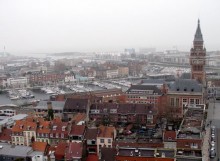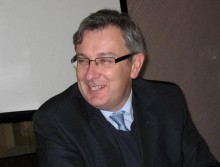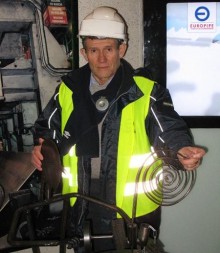Bertrand Ringot, the mayor of Gravelines, the town where one of France’s first nuclear power plants (six nuclear units) is situated, says there were failures in the first years of the plant’s operation. Unfortunately, the plant’s top managers were the first to drive or run to the railway station in order to stay away from the dangerous installation. After this, the authorities insisted that the nuclear giant’s managers and their families live in the city and their children go to local schools. “This essentially boosts reliability of the nuclear power plant,” the mayor says convincingly and adds, “as well as the trust of residents.”
Gravelines was founded in the olden pre-nuclear times. You can find the town’s name in the French prestigious Michelin Red Guide. The Count of Flanders had a rampart put up here in the 12th century. Now tourists bypass it on a pleasure boat through the water-filled moat. There are also a lot of other sights to see. Ukrainian journalists ascended the Beffroi, a tall church tower (five elevator flights and 60 tiers of narrow winding stairs). This opens a good view of the local seaport with hundreds of ships and yachts. The hardworking French built it by slightly changing the stream and deepening the bed of the Aa River so that big ships could sail through. The port linked Graveline with many countries and promoted its development.
Today, the nuclear power plant plays this role. It annually allocates 100 million euros to the national budget and attracts investors to the town because the price of electricity is of great importance for them. Thanks to the plant’s proximity, this price is lower. Graveline has an aluminum plant that employs 600 people and a Europipe works to which quality control costs perhaps even more than production. What guarantees stability for these energy-consuming businesses is the fact that the electricity rate for them will remained unchanged until 2017.
Yet prices in this small town are slightly higher than in Paris. Besides, taxes set by the previous well-respected mayor remain rather high, the mayor told The Day. But, in his words, this allows the current local authorities to impose a 45-percent tax cut for large families. Nevertheless, each new election in the town is preceded by “green” protests against the nuclear power plant.
In what way do the authorities react to this? Immediately after the Chornobyl accident, Gravelines established, as France’s other nuclear centers did, the so-called local information commission with Mayor Ringot at the head. Its aim is not only to notify people about likely faults, but also to offer explanations to the populace and avert panic that may be caused by political events. The main function of the commission that consists of half the municipal council members is to know the situation at the nuclear power plant and prevent plant workers from committing even the slightest violations. One of the forms of its work is reports on nuclear safety measures. “We are the leading commission in France,” the mayor says proudly to journalists and tells them about the commission’s newspaper and website. Yet he does not conceal that there were quite a few small faults at the plant last year.
The Day inquired about the way the commission is funded. Ringot said it is done as part of public-private partnership, but he emphasized that no money is taken from the company EDF which owns the nuclear power plant.
But Graveline’s main particularity today, which has drawn the rapt attention of the Ukrainian journalists, is the construction of an LNG-terminal. This construction is also being funded as part of public-private partnership. According to the mayor, the terminal’s annual capacity will be 3 billion cubic meters of gas, which accounts for almost 20 percent of total gas consumption in France.
As the terminal will be built near the nuclear power plant, it is a no-go zone for foreigners. Yet we were shown the future construction site from afar and told that there would be tanks here, each of which could easily contain the Eiffel Tower. But, so far, there is nothing special here at first glance – just a sloping deserted bank grown over with shrubs. And it is perhaps not the best place to ask a tricky question: where do you think re-gasification heat will be coming from? To be frank, none of us, including The Day, managed to give the right answer. The resourcefulness of French engineers struck us: they are going to lay a pipeline from the nuclear power plant, which will deliver the hot water that cools the reactor.
A very bold and unconventional technical decision! I wonder where re-gasification heat will be taken from at the Ukrainian LNG-terminal, the place for which is now being searched on the Turkish territory. If the place is found, will bids be invited again for the feasibility report?
Meanwhile, the Ukrainian journalists managed to speak in Paris to representatives of Technip, a world leader in project management, engineering, and construction for the energy industry. It employs about 35,000 people in many countries and has over 30 modern ships for underwater operations. The company has the experience of building this kind of facilities – it constructed a terminal in Texas, US. It also took part in the negotiations about the construction of a Ukrainian LNG-terminal and is prepared to take up dredging work and build a land-based turnkey re-gasification complex. Yet the company executives, who emphasize their complete political indifference, are somewhat worried because they still do not know where, in what country, is the so much talked-about facility which will be working for Ukraine’s energy independence.
The Day expresses gratitude to the Foreign Ministry and Embassy of France in Ukraine for superb organization of this highly informative visit, as well as to all the representatives of central and local governmental bodies and companies, who found time to communicate with Ukrainian journalists.









